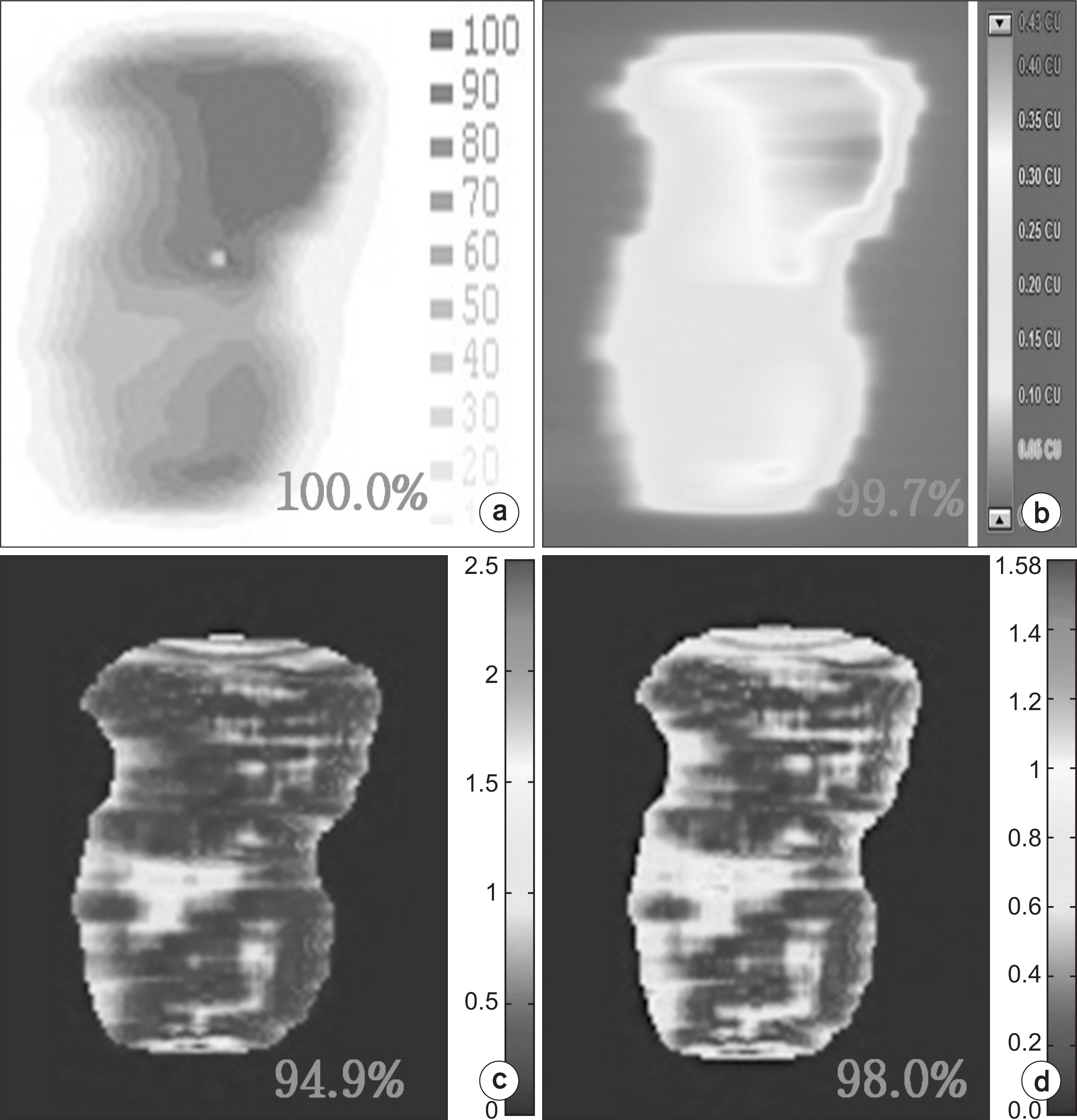Prog Med Phys.
2017 Jun;28(2):54-60. 10.14316/pmp.2017.28.2.54.
Feasibility Study of Patient Specific Quality Assurance Using Transit Dosimetry Based on Measurement with an Electronic Portal Imaging Device
- Affiliations
-
- 1Department of Radiation Oncology, National Health Insurance Co. Ilsan Hospital, Goyang, Korea.
- 2Department of Bio-convergence Engineering, Korea University, Seoul, Korea. radioyoon@korea.ac.kr
- KMID: 2388209
- DOI: http://doi.org/10.14316/pmp.2017.28.2.54
Abstract
- This study was designed to measure transit dose with an electronic portal imaging device (EPID) in eight patients treated with intensity modulated radiotherapy (IMRT), and to verify the accuracy of dose delivery to patients. The calculated dose map of the treatment planning system (TPS) was compared with the EPID based dose measured on the same plane with a gamma index method. The plan for each patient was verified prior to treatment with a diode array (MapCHECK) and portal dose image prediction (PDIP). To simulate possible patient positioning errors during treatment, outcomes were evaluated after an anthropomorphic phantom was displaced 5 and 10 mm in various directions. Based on 3%/3 mm criteria, the mean±SD passing rates of MapCHECK, PDIP (pre-treatment QA) for 47 IMRT were 99.8±0.1%, 99.0±0.7%, and, respectively. Besides, passing rates using transit dosimetry was 90.0±1.5% for the same condition. Setup errors of 5 and 10 mm reduced the mean passing rates by 1.3% and 3.0% (inferior to superior), 2.2% and 4.3% (superior to inferior), 5.9% and 10.9% (left to right), and 8.9% and 16.3% (right to left), respectively. These findings suggest that the transit dose-based IMRT verification method using EPID, in which the transit dose from patients is compared with the dose map calculated from the TPS, may be useful in verifying various errors including setup and/or patient positioning error, inhomogeneity and target motions.
Keyword
Figure
Reference
-
1. Langer M, Brown R, Urie M, Leong J, Stracher M, Shapiro J. Large scale optimization of beam weights under dose-volume restrictions. Int J Radiat Oncol Biol Phys. 1990; 18:887–93.
Article2. Langer M, Leong J. Optimization of beam weights under dose-volume restrictions. Int J Radiat Oncol Biol Phys. 1987; 13:1255–60.
Article3. Morrill SM, Lane RG, Wong JA, Rosen II. Dose‐volume considerations with linear programming optimization. Med Phys. 1991; 18:1201–10.
Article4. Low DA, Moran JM, Dempsey JF, Dong L, Oldham M. Dosimetry tools and techniques for imrt. Med Phys. 2011; 38:1313–38.
Article5. Olch AJ. Dosimetric performance of an enhanced dose range radiographic film for intensity-modulated radiation therapy quality assurance. Med Phys. 2002; 29:2159–68.
Article6. Ma C, Jiang S, Pawlicki T, Chen Y, Li J, Deng J, et al. A quality assurance phantom for imrt dose verification. Phys Med Biol. 2003; 48:561.
Article7. Berry SL, Sheu R-D, Polvorosa CS, Wuu C-S. Implementation of epid transit dosimetry based on a through-air dosimetry algorithm. Med Phys. 2012; 39:87–98.
Article8. Saitoh H, Fujisaki T, Sakai R, Kunieda E. Dose distribution of narrow beam irradiation for small lung tumor. Int J Radiat Oncol Biol Phys. 2002; 53:1380–87.
Article9. Van Esch A, Depuydt T, Huyskens DP. The use of an asi-based epid for routine absolute dosimetric pre-treatment verification of dynamic imrt fields. Radiother Oncol. 2004; 71:223–34.
Article10. McDermott L, Wendling M, Van Asselen B, Stroom J, Sonke J-J, Van Herk M, et al. Clinical experience with epid dosimetry for prostate imrt pre-treatment dose verification. Med Phys. 2006; 33:3921–30.
Article11. Van Esch A, Vanstraelen B, Verstraete J, Kutcher G, Huyskens D. Pre-treatment dosimetric verification by means of a liquid-filled electronic portal imaging device during dynamic delivery of intensity modulated treatment fields. Radiother Oncol. 2001; 60:181–90.
Article12. McDermott LN, Wendling M, Sonke J-J, van Herk M, Mijnheer BJ. Replacing pretreatment verification with in vivo epid dosimetry for prostate imrt. Int J Radiat Oncol Biol Phys. 2007; 67:1568–77.
Article13. Berry SL, Polvorosa C, Cheng S, Deutsch I, Chao KC, Wuu C-S. Initial clinical experience performing patient treatment verification with an electronic portal imaging device transit dosimeter. Int J Radiat Oncol Biol Phys. 2014; 88:204–09.
Article14. Oldham M, Sakhalkar H, Guo P, Adamovics J. An investigation of the accuracy of an imrt dose distribution using two-and three-dimensional dosimetry techniques. Med Phys. 2008; 35:2072–80.15. Sabet M, Rowshanfarzad P, Vial P, Menk FW, Greer PB. Transit dosimetry in imrt with an a-si epid in direct detection configuration. Phys Med Biol. 2012; 57:N295.
Article16. Baek TS, Chung EJ, Koh EK, Seo J, Yoon M. Evaluation of the accuracy of dose delivery for imrt based on transit dosimetry. Health Phys. 2014; 107:200–5.
Article17. Baek TS, Chung EJ, Son J, Yoon M. Feasibility study on the verification of actual beam delivery in a treatment room using epid transit dosimetry. Radiat Oncol. 2014; 9:273.
Article18. Low DA, Harms WB, Mutic S, Purdy JA. A technique for the quantitative evaluation of dose distributions. Med Phys. 1998; 25:656–61.
Article
- Full Text Links
- Actions
-
Cited
- CITED
-
- Close
- Share
- Similar articles
-
- Development of Dose Verification Method for In vivo Dosimetry in External Radiotherapy
- A Comparison between Portal Dosimetry and Mobius3D Results for Patient-Specific Quality Assurance in Radiotherapy
- Clinical performance of FractionLab in patient-specific quality assurance for intensity-modulated radiotherapy: a retrospective study
- Feasibility Study of Mobius3D for Patient-Specific Quality Assurance in the Volumetric Modulated Arc Therapy
- Basic Dose Response of Fluorescent Screen-based Potal Imaging Device




